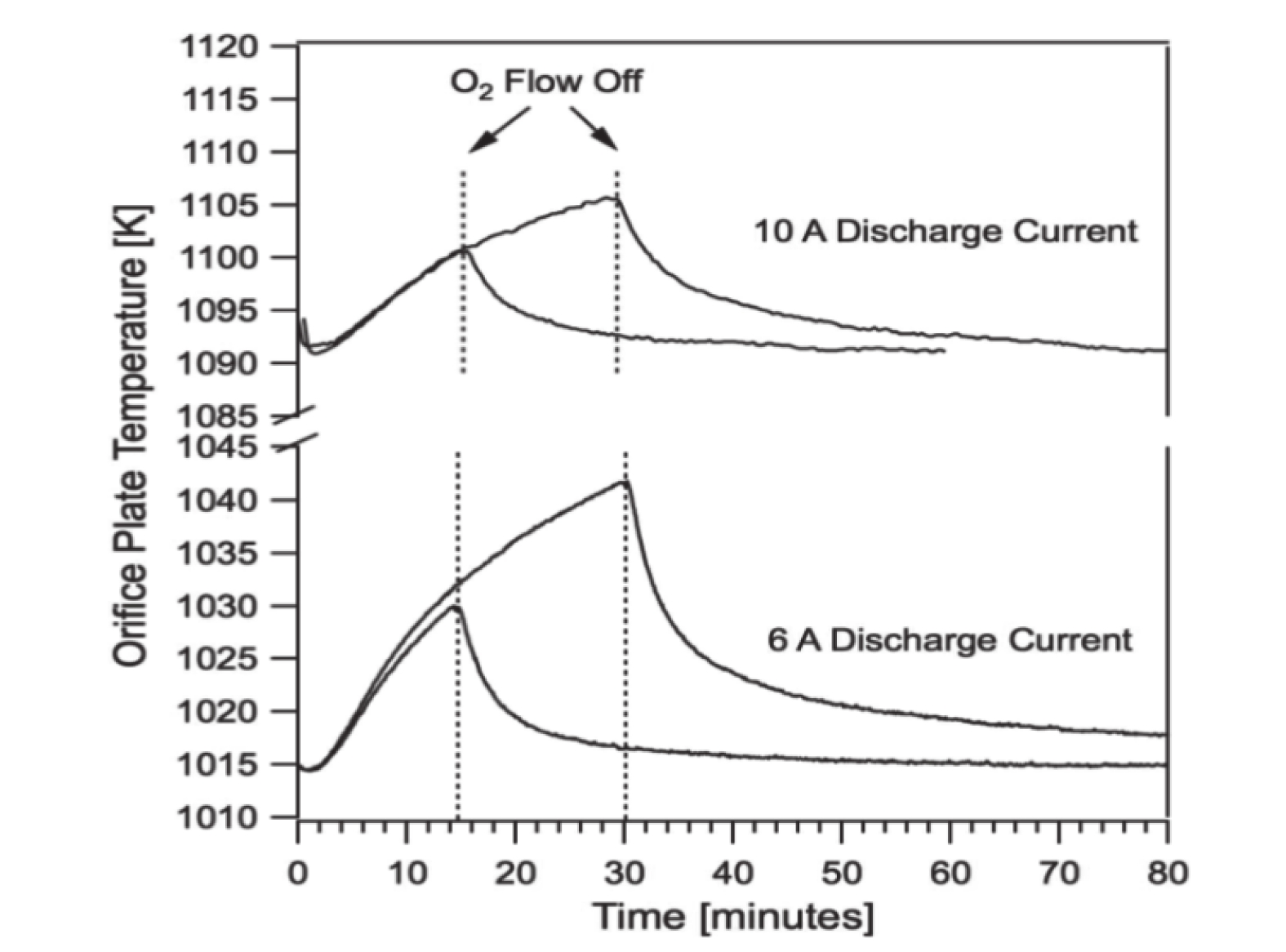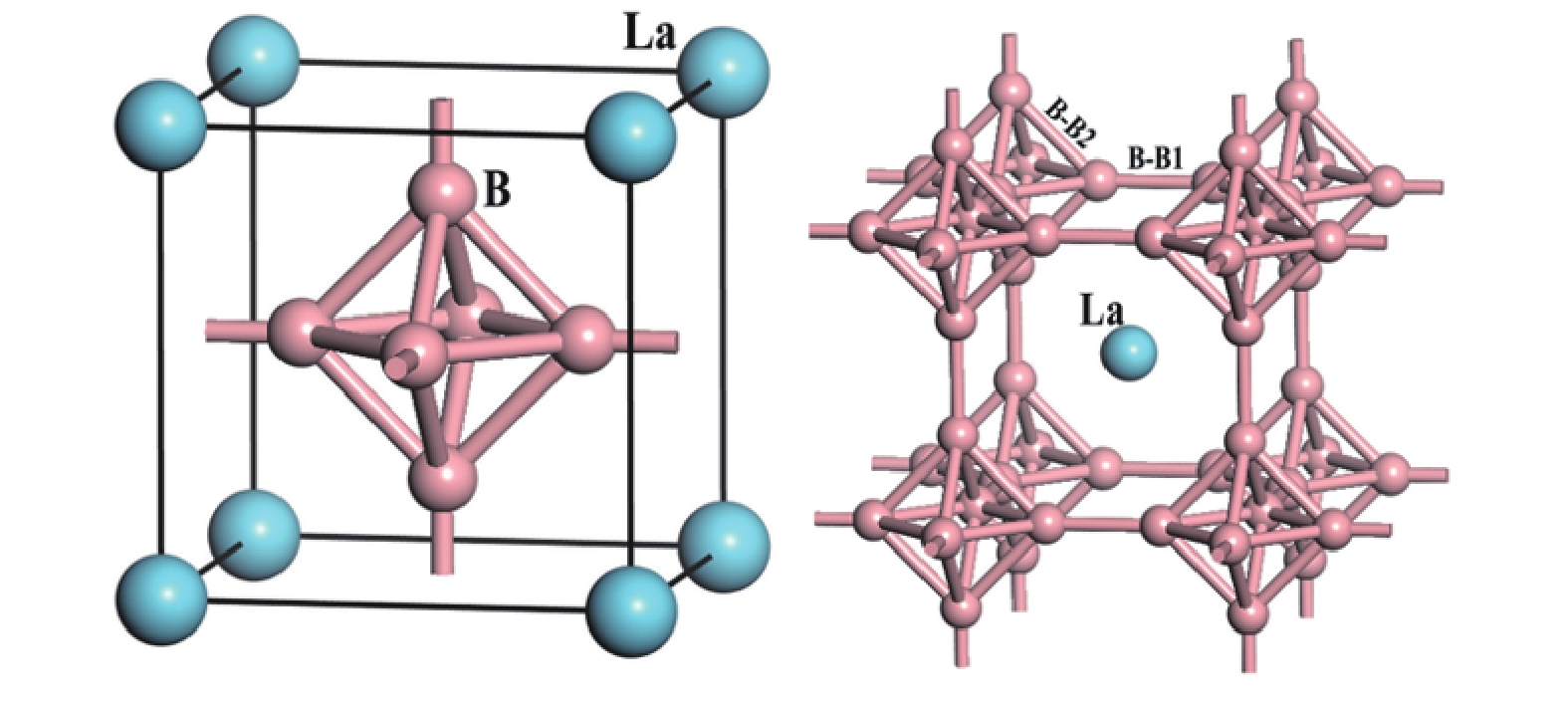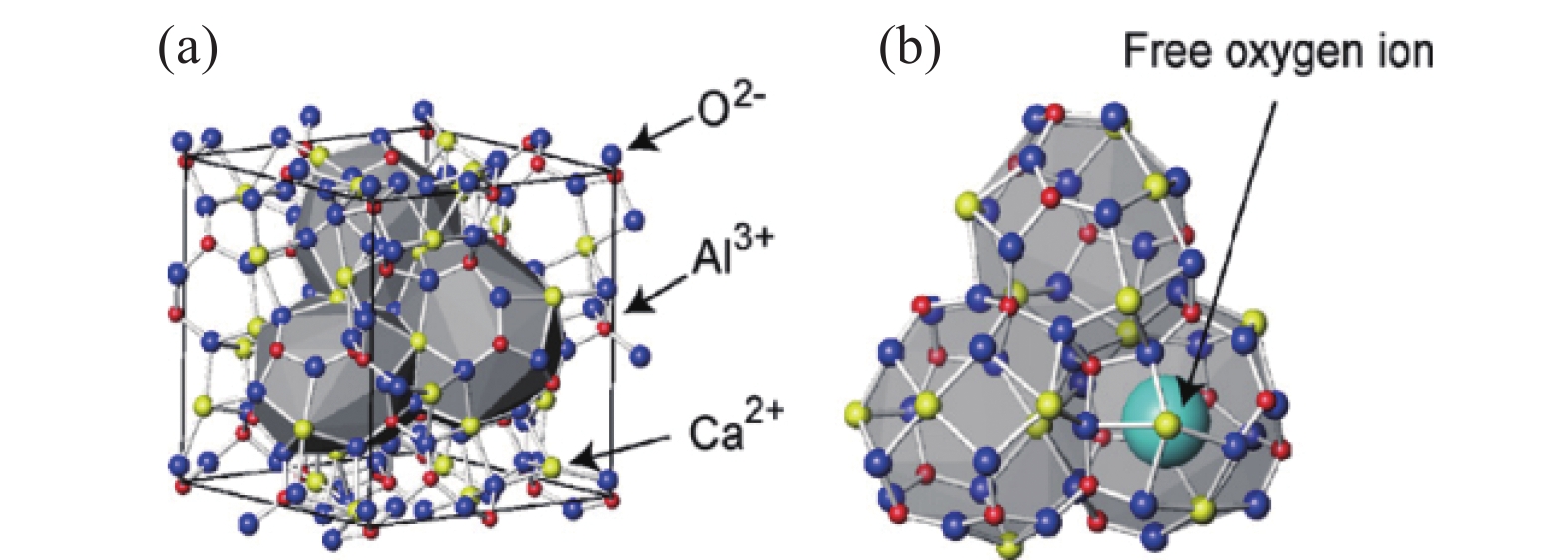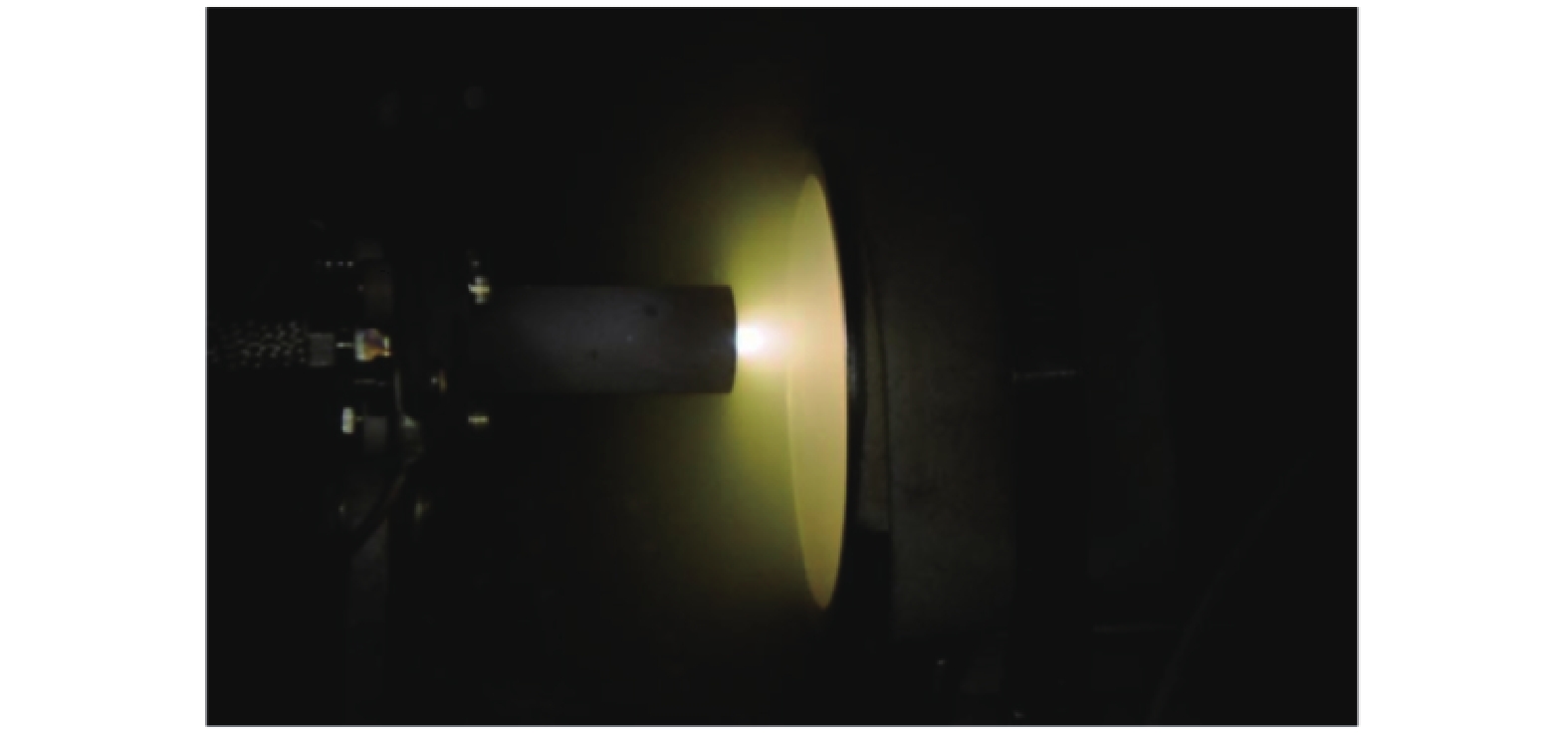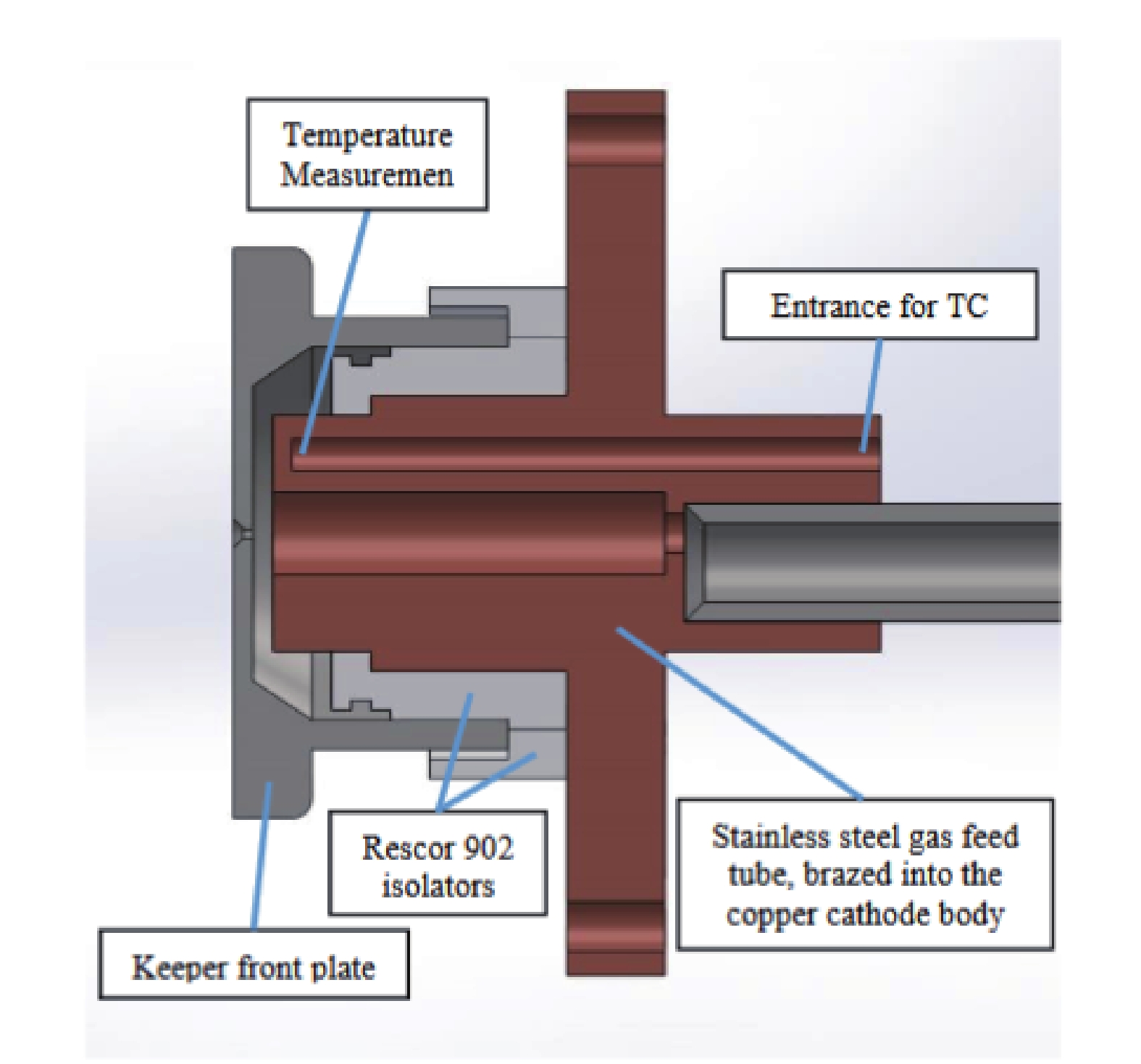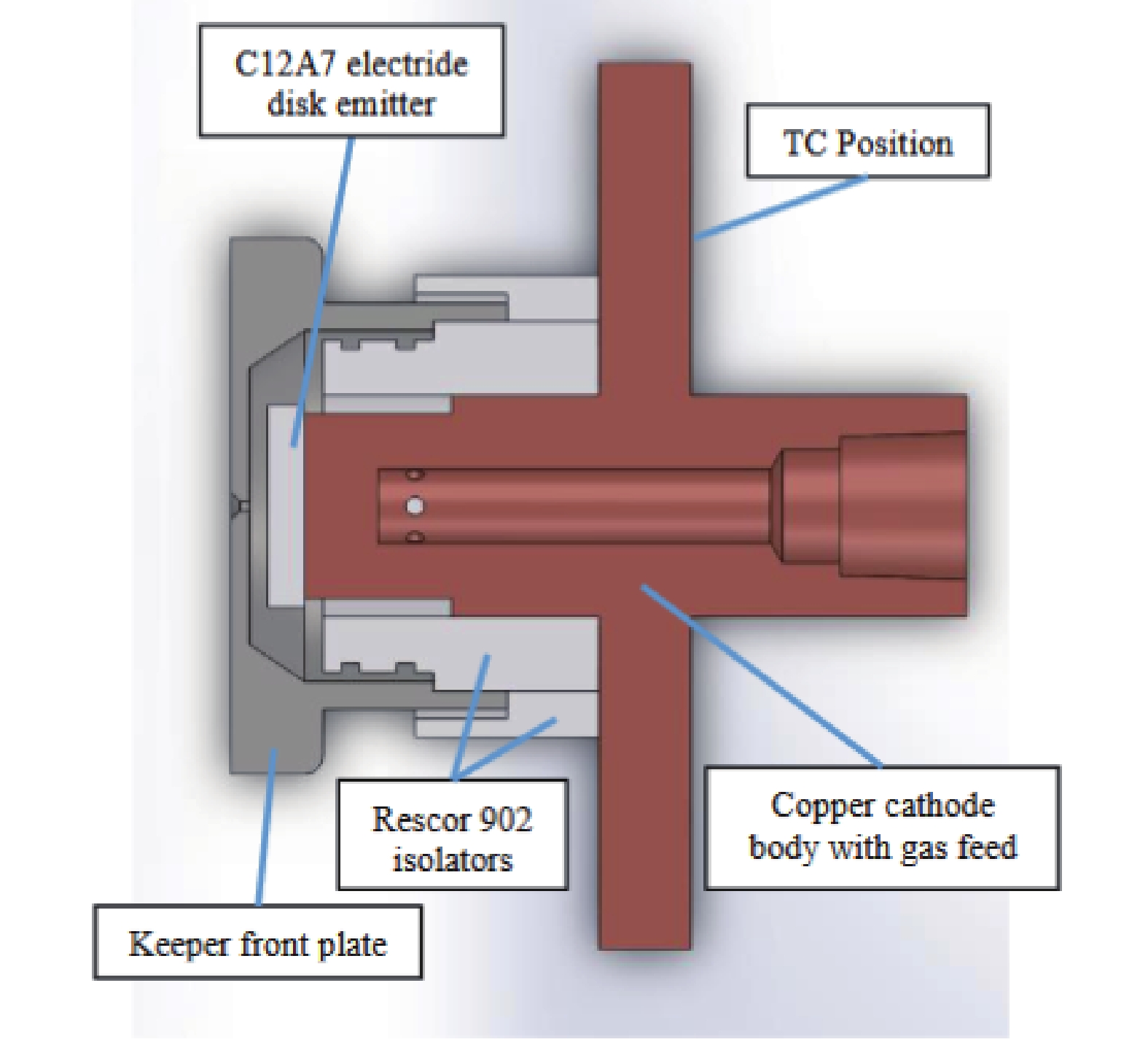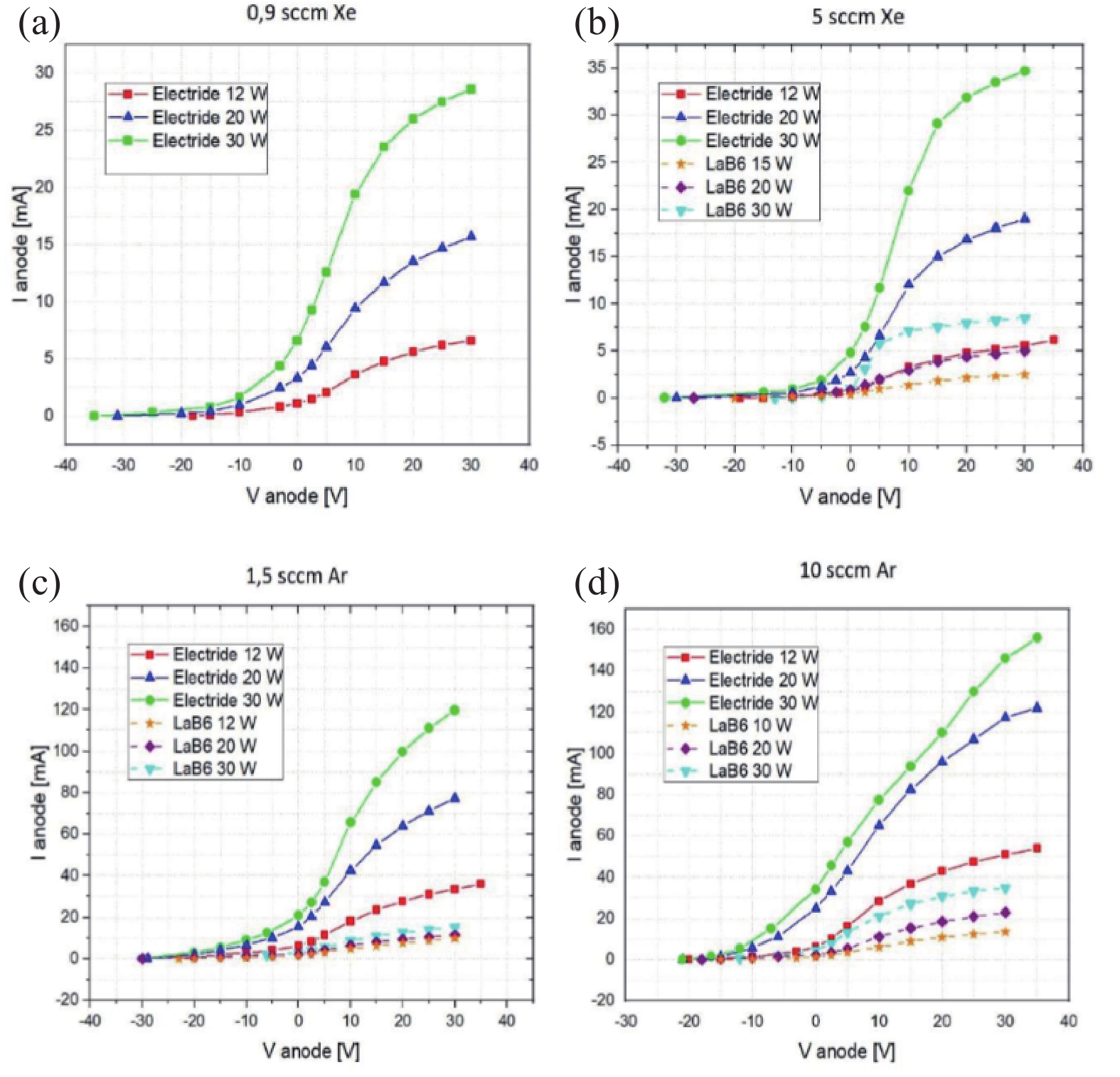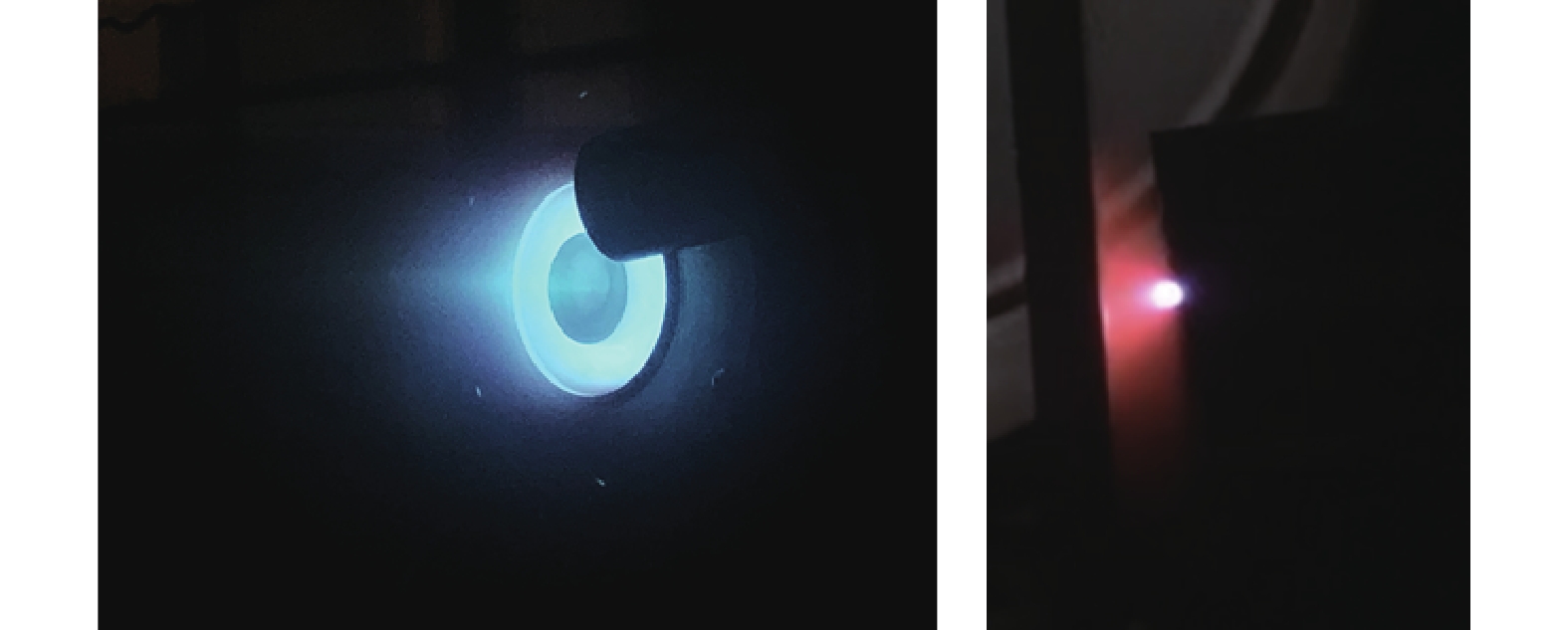-
电推进理论始于20世纪初,它是利用电能加热、离解和加速工质形成高速射流而产生推力的技术。电力推进技术的发展直接推动了人类航天事业的发展,为人类探索宇宙奥秘提供了动力。空心阴极发射体作为电推力器的重要组成部分,要求具有电子发射性能高、逸出功低、抗中毒能力强和抗振动能力强等特点。因此,空心阴极发射体的研究与开发成为推动整个电推进技术发展的关键。
目前,电推进系统空心阴极常用的发射体主要有BaO-W和LaB6阴极。BaO-W的工作温度约为1100℃,逸出功约为2.1 eV,但其对工质要求较高[1]。LaB6的工作温度超过1 500℃,逸出功约为2.7 eV,工作温度高导致功耗较大[1-2]。近年来,C12A7电子化合物因其低的逸出功和工作温度,引起国内外学者的高度关注,虽然目前从实验上尚未得到理论计算上的0.6 eV低逸出功,但预计工作温度低至 600℃,且与碘工质表现出良好的兼容性[1,3],因此其被认为在碘工质方面具有极大的开发潜力。本文将回顾主要的几种空心阴极发射体材料在电推进系统研究与开发中的最新进展。
-
BaO-W阴极是将钡的耐熔盐(铝酸盐、钨酸盐、钪酸盐等)等活性发射物质直接浸渍并存储于钨海绵体的多孔孔隙内,钨海绵体承担了阴极金属骨架的作用。其中阴极表面Ba 覆盖层是由钨与铝酸盐在高温下发生化学反应产生的Ba原子沿着孔通道扩散至阴极表面形成的,这一过程降低了阴极材料的逸出功[4],并提高其电子发射能力。普通钡钨阴极逸出功低的原因是表面存在 Ba-O 单原子层的低逸出功结构。在传统铝酸盐中添加钪,制得的钪酸盐阴极在 1030℃时,发射电流密度高达 400 A/cm2[5],并且逸出功得到进一步的降低。BaO-W阴极具有发射电流密度高、服役寿命长、逸出功低等优点,被广泛应用于大功率真空电子器件。然而BaO-W阴极易与空气中的水、氧气、二氧化碳等发生反应,造成发射体性能的退化,表现出中毒现象。因此,未来如何提高BaO-W阴极的抗中毒能力,解决空心阴极发射体性能退化等问题,是进一步延长空心阴极发射体寿命的关键。
-
早在1950年,利物浦公司就研发了储备式钡钨型阴极,又称 L 型阴极。现在的BaO-W阴极继承了L 型阴极的优点,在改成浸渍式阴极的同时,改用钡的耐熔盐等提高其发射性能。BaO-W作为传统的发射体材料,国内外众多科研机构进行了开发和应用。
最早有关BaO-W空心阴极的研究主要集中在美国、俄罗斯以及部分欧洲国家。例如俄罗斯航天国家集团使用氧化钡作为热离子材料,并应用在SPT-100型推力器上[6];英国研发了采用BaO-W发射体的T5 空心阴极与 T6 空心阴极[7];美国将XIPS-25 离子电推进系统成功应用在 HS-601,HS-702 通讯卫星上[8];乌克兰用NIC M1. 05,NIC M5.04 空心阴极分别替代俄罗斯的 KE-5A,KN-3 空心阴极,在 SPT-70,SPT-100 霍尔推力器中进行了试验[9];德国空间局为HEMP-T3050 离子推力器开发了HKN 5000 空心阴极[10];上海空间推进研究所开发了BaO-W发射体的空心阴极,并应用于SPT-70 霍尔推力器[11]。
近年来,各国研究机构一直致力于提高BaO-W空心阴极的寿命。2010年,南安普敦大学的Coletti等[12]开发了可预测发射体中氧化钡消耗的理论模型,并结合实验结果,认为BaO会与其他浸渍材料(CaO和Al2O3)发生反应,而且在发射体工作过程中Ba元素会不断的蒸发,造成寿命的降低。美国喷气推进实验室的Polk等[13,14]进行了BaO-W空心阴极的8200 h寿命演示试验,并采用深空一号备用推力器进行了延长寿命测试试验,最终累积测试时长达到30352 h。试验后发现发射体内壁的下游端有密集的钨沉积物,但在整个试验过程中空心阴极运行正常,并没有出现性能下降的迹象。为了进一步验证Ba损失仅限于发射体下游端附近的狭窄区域,他们再次将空心阴极在 3.7 mL/min Xe 流量和13 A -15.2 A 电流范围内运行了 8200 h,测试后发现发射体中Ba的损失非常小,仅发生在距下游端约 4 mm的狭窄的区域,最大耗尽深度仅为 50 μm,因此认为Ba的蒸发不会成为造成故障的关键因素[15]。
美国加州理工学院的Capece等认为空心阴极中的BaO-W发射体与推进剂中的反应性杂质在高温下工作,会加快发射体的蒸发,从而降低使用寿命,并通过试验评估了BaO-W阴极寿命,同时研究了工质中氧含量对BaO-W发射体发电特性的影响(如图2所示)。在氙气中氧浓度为100 ppm ,放电电流分别为6 A 和 10 A,混合气体流量为 2.5 mL/min测试条件下,在 10 A运行30 min后,发射体温度升高14 K,在 6 A 运行30 min后,温度升高27 K。表明在较低放电电流下运行时,BaO-W发射体更容易中毒,提高放电电流可以提高抗中毒能力[16-18]。
在延长空心阴极的使用寿命的同时,为了满足微型卫星系统以及微型航天器的快速发展需求,研发低功率、小型化电推力器正受到各国研究机构的关注。传统的电推力器通常采用超高纯度的氙气作为工质,然而氙气的价格昂贵。碘作为一种潜在可替代氙的固态工质,可在兼顾高比冲的情况下,实现电推进系统的轻质、小体积和低成本。2018年,美国宇航局格伦研究中心的Benavides等对BaO-W空心阴极与碘工质的相容性进行了研究。在测试过程中,发现BaO-W在碘工质中Ba的消耗率较高,而且点火不稳定,无法稳定工作。由此认为BaO-W阴极无法在碘推进剂中长时间工作,无法满足美国宇航局的碘卫星(ISat)任务要求。为了满足任务的需求,他们采用了碘和氙气两套推进剂系统,与全氙气系统相比,可以显著减少总推进剂罐的体积[19-22]。美国伍斯特理工学院的Zachary等[23]发现BaO-W 空心阴极在碘推进剂中工作时,在相同的放电电流下,在碘工质中需要更高的功率来维持点火和放电,猜测其原因可能与碘的密度和流速有关。可见,碘工质对发射体与工质相容性方面提出了新要求。
BaO-W是最常见应用于空心阴极发射体的低逸出功材料之一,但BaO-W空心阴极的寿命也受到各种因素限制,如BaO-W阴极存在Ba元素的蒸发率偏高,易发生因水和氧的中毒等缺点,因此如何解决这些限制因素进一步提高BaO-W空心阴极的寿命,是今后研究的热点和重点。
-
LaB6是由稀土元素La和非金属元素B组成,它是由原子半径较大的La原子和原子半径较小的非金属B组成的简单立方体,由于硼原子间的结合力很强,因此使得LaB6硬度大,熔点高。并且B原子形成的基体把稀土La原子紧密的包围在格架之间形成非常稳定的三维格架[24],这不仅使 LaB6 的化学性质十分稳定,而且还增加其耐离子轰击能力。La元素的3个价电子分布为5d16s2,其中2个价电子与B成键,1个电子不成键,相对自由,这也是LaB6具有较好的导电和电子发射特性的根本原因[25-27]。这些优良的特性使得LaB6作为空心阴极时具有较长的使用寿命,通常可达几千甚至上万小时。因此其在国防军工领域以及民用领域都得到广泛的应用。然而LaB6阴极材料相对于钡钨阴极材料来说逸出功较高,这就导致了空心阴极的工作温度较高,进而导致了相同的工作条件下,需要更高的运行功率[2]。因此如何降低LaB6空心阴极工作温度,更好的服务于空间电推进系统是未来研究趋势。
-
自1951年Lafferty发现LaB6和CeB6具有优异的热发射特性以来,国内外学者对稀土六硼化物的研究越来越重视[28-30]。20世纪60年代,美国IBM公司的发现LaB6阴极比起BaO-W阴极具有发射电流密度高和空间分辨率高等优势[31],随后LaB6被广泛地应用于空间电推进等多个领域。早在上世纪,俄罗斯就研制出了 100 多台使用LaB6空心阴极的霍尔推进器[32-34]。虽然 LaB6 阴极比传统的BaO-W阴极需在更高的温度下工作,但与BaO-W阴极相比,它提供了非常高的放电电流,并且寿命更加长,对推进剂中杂质和空气暴露的敏感性更低。
国外对于LaB6的研究相对于国内来说起步较早,像美国、日本、俄罗斯以及英国等欧洲国家都是较早从事相关研究的国家。美国喷气推进实验室(JPL)的Goebel等开发了拟用于针对小行星重定向自动化任务 (ARRM) 开发的12.5千瓦霍尔推进器的LaB6空心阴极,该阴极已在测试设备中成功运行。该阴极寿命评估测试结果表明,在 15 A - 32 A 放电电流下阴极寿命超过 1×105 h,并预测在 50 A 的放电电流下,其寿命也可超过 5×104 h [35]。随后他们又开发出了可满足小空间和轻质量要求的紧凑型LaB6空心阴极,其直径小于 2 cm,长度为 6-15 cm,能够在氙气中以 5 A−60 A 的放电电流连续工作。随后又开发出了直径稍大,可在发电电流高达 100 A 的工况下运行的LaB6空心阴极[36]。美国喷气推进实验室(JPL)Becatti等开发了一种小电流、超紧凑、无加热器的LaB6空心阴极,已被用于微型磁屏蔽霍尔推进器,并进行了点火循环试验,成功超过25000次阴极无加热器点火。该测试结果也表明,为下一代星际任务设计的低功率、无加热器空心阴极的研发迈出了重要的一步[37]。此外美国喷气推进实验室针对太空探测任务设计的LaB6空心阴极在阴极测试设施中展示了10 A−300 A 的稳定放电电流[38-39]。美国加州大学洛杉矶分校的Chu等[40]开发了以LaB6为空心阴极的高功率霍尔推进器,测试结果表明该霍尔推力器可在20-100 A电流下稳定工作。
国内兰州空间技术物理研究所也是较早开发了LaB6空心阴极,研发的5A空心阴极已经装备到了LIPS-200、LIPS-300 离子推力器、LIPS-100霍尔推进器和航天器主动电位控制系统等,其中LIPS-200离子电推进系统已经在在SJ-9卫星成功应用[2]。该所对LaB6空心阴极在Xe流率为0.1 mg/s,真空度为2×10- 3 Pa的条件下,进行了3500 h 的寿命试验。测试过程中空心阴极性能稳定,而且仍然可以正常运行。随后利用寿命模型预测LaB6空心阴极的寿命可达到 40000 h 以上[41]。
LaB6 发射体作为电推进系统的核心部件,工作温度需要高于1500ºC 的温度,因此LaB6 阴极的设计面临着热性能和机械性能的挑战。Kokal等通过分析对比几种 LaB6 空心阴极的结构,发现材料的选择和结构设计对于延长其寿命至关重要。针对传统加热器设计遇到的温度高难题,他们设计出了一种带有同轴加热器的阴极,显著提高了阴极寿命[42]。近年来日本对LaB6应用方面的研究进展十分迅速,他们的研究成果主要服务于各类电子显微镜阴极,Hisato Yamaguchi等通过给LaB6增加单层六方氮化硼(hBN)涂层有效降低了逸出功,与未增加涂层的区域相比逸出功降低了0.4 eV,并且经过验证试验结果与理论结果一致,这在进一步降低LaB6逸出功方面提供了新的思路[43]。此外日本宇宙航空研究开发机构设计了一种辐射加热器,有效降低了加热器因磨损而失效的风险[44]。Ning等[45]设计了一种无加热器 LaB6 空心阴极,成功进行了1×104次点火循环试验,通过对沉积物的分析,认为La和B元素的蒸发是LaB6 发射体主要腐蚀机制。Shu等[46]通过LaB6中掺杂Ce降低了逸出功,有望降低工作温度,这也为降低LaB6 工作温度提供了新思路。
目前,LaB6单晶阴极的工作温度仍然偏高,通常在1500℃以上,这不仅影响阴极寿命也对器件的工作环境提出了更高的要求,而且其发射性能也有待于进一步提高。因此如何降低稀土六硼化物的逸出功,进一步提高阴极的发射能力,研发出在保持一定电流密度的前提下,具有更低工作温度的阴极,再或者在保持工作温度不变的前提下,电流密度有大幅度提高的阴极,是一个亟待解决的问题,也是今后稀土六硼化物发射体研究的热点和发展方向。
-
七铝酸十二钙(化学式12CaO·7Al2O3,简写:C12A7)是一种具有天然纳米笼腔结构的化合物,晶体结构呈立方型,每个晶胞中包含由两个C12A7分子形成的12个共面连接的直径约为0.4 nm的笼腔,12个笼腔内含有两个“自由”的O2−离子(如图4所示)。因该O2−与主体框架之间的结合力较弱,所以O2−可以在12个笼子间穿行,容易挣脱框架的束缚[47-49]。因此,笼腔内的O2−也可以被其它与之半径相近的一价负离子(H−,O−,F−,Cl− )替代形成C12A7的各种衍生物,当完全被电子e−取代,则形成C12A7的电子化合物[Ca24Al28O64]4+:4e−[50-55]。C12A7电子化合物具有与碱金属Cs(2.1 eV)、Rb(2.2 eV)、K(2.3 eV)、Na(2.8 eV)相当的低逸出功(理论上可达0.6 eV[56]),而且在惰性气氛中可以在1200℃以内稳定工作,并且在500℃以下的空气气氛中可以稳定存在,因此与传统空心阴极材料BaO-W和LaB6相比,C12A7电子化合物具有逸出功低、工作温度低、化学稳定性好、成本低等特点,有望成为一种新型阴极材料[57]。
-
美国是较早研究C12A7电子化合物并将其应用于空心阴极的国家之一。科罗拉多州立大学电力推进与等离子体工程实验室(CEPPE Lab)的Rand 首次将 C12A7 电子化合物作为发射体并应用于空心阴极。多次测试阴极均可在室温下瞬间被点燃,测得阳极为 55 V,触持极 25 V,并且当以25 mL/min流量供应氩气时,阴极可以以2.7 A 的电流稳定工作[58]。随后科罗拉多州立大学又与Busek公司合作,验证了C12A7电子化合物阴极在碘工质中的兼容性,在室温下测试了碘工质中C12A7电子化合物阴极并成功重复性点火(如图5所示),经过 20 h测试,C12A7阴极在碘工质中表现出较好的兼容性,未出现退化或者污染的现象,最高放电电流可达 15 A[59]。
美国海军研究实验室的McDonald等在对C12A7电子化合物空心阴极的点火和工作特性研究过程中发现,测试后的发射体出现了碎裂现象,发生碎裂的C12A7电子化合物颜色发生明显的改变,铜孔板上能明显观察到熔融物的溅射。笔者认为可能是热应力导致发射体发生破裂,发射体被氧化或发生分解而引起颜色变化[60]。
德国、西班牙等欧洲国家也开展了有关C12A7电子化合物在电推进应用方面的研究。德累斯顿工业大学的Christian等设计了新的阴极结构(图6,图7所示),该结构使温度分布均匀,并且易于制作和组装。新空心阴极结构采用圆盘状发射体,克服了以往的空心阴极装置中存在的发射体某些位置经常被熔化的缺点。测试过程发现发射体放电的稳定性显著提高,而且放电时间达到300多小时[61]。随后德累斯顿工业大学的Christian等对C12A7电子化合物空心阴极进行了寿命测试试验。在测试过程中,发射体运行约75小时后,放电稳定性显著提高,最后在连续工作950多个小时后,由于推进剂供应问题导致实验终止。在整个测试过程中,C12A7电子化合物的放电表现出极大的稳定性[62]。
2022年,西班牙的Toledo等对LaB6和C12A7电子化合物作为发射体的电子发射性能及其在工质中的放电特性进行了性能比较。热电子发射性能测结果表明,C12A7电子化合物具有优异的电子发射性能,可作为电推进系统空心阴极或热电子的发射体。二者在工质中的放电特性(如图8所示)实验结果表明,C12A7电子化合物在Ar和Xe工质中都表现出明显的优势,并且在较低的工质流量和阴极功率下具有更好的稳定性。从实验结果还可以看出, C12A7电子化合物的Ia/Pc在Ar中约为3.3 mA/W,在Xe中约为1 mA/W,这也表明C12A7电子化合物在温度低于250℃的中和器中,作为冷阴极具有极大的可能性[63]。
C12A7电子化合物在相关测试中表现出的优良性能,同样引起了国内各大研究机构的关注。上海交通大学与北京工业大学联合开展了C12A7电子化合物失效行为的研究,认为工作温度过高引起发射体工作面发生熔融和分解,发射体的分解是导致阴极点火困难的主要原因。由此可见,有效控制发射体工作温度低于其熔点温度是保证空心阴极正常工作的重要前提[64]。上海交通大学的Hua等进行了C12A7电子化合物空心阴极与低功率霍尔推力器的联合运行试验。为了避免C12A7电子化合物发射体在无加热器频繁点火过程中出现熔化和性能退化,设计了一种带加热器的C12A7空心阴极。图9为C12A7空心阴极放电及其与霍尔推力器HET-50在200 W放电功率下的联合运行的照片。试验结果表明,在加热电流5.8 A,氙气流量2 -10 mL/min,点火电压300 V的条件下,C12A7空心阴极可在数分钟内启动,并实现了放电电流1-4 A下的稳定自持放电。 C12A7空心阴极的总运行时间在一个月内达到十个小时以上,没有任何明显的退化,表明C12A7空心阴极具有快速启动的优异性能,在电推进和替代传统空心阴极方面已经显示出极大潜力[65]。
目前,开发应用于小功率电推力器的新型阴极材料,成为当前电推进领域的研究热点,C12A7电子化合物的逸出功低、抗中毒能力强且与碘工质兼容等特点有望成为新一代发射体材料,但空心阴极存在着放电不稳定,在较高的工作温度下性能退化等问题[66]。未来研究者可以通过掺杂少量其它元素进而起到优化其晶体结构和电子发射性能的作用;或者通过引入表面修饰层或涂覆特殊材料对C12A7电子化合物的表面进行修饰来改善其电子发射性能;再或者通过优化改良空心阴极发射体的设计提高其在电推进系统的应用能力等方式来解决这些问题。因此,如何优化 C12A7:e-合成工艺并提高其热发射性能,进而提高其使用寿命,是未来研究的难点和重点。
-
综合国内外电推进系统空心阴极发射体材料的研究与开发进展现状来看,LaB6和BaO-W等阴极材料仍然是空心阴极发射体最常用的材料,但LaB6阴极工作温度高、功耗较大,BaO-W阴极虽然工作温度低,但抗中毒能力差,特别是在大气中容易发生不可逆的中毒,随着各国对小功率的电推进装置需求的增加以及固态碘工质在电推进系统中的应用,这对发射体与工质的兼容性、长寿命等提出了更高的要求。C12A7电子化合物作为新型发射体材料,表现出逸出功低、工作温度低、与碘工质相容性良好等优点,使其在小功率电推进装置的应用极具研究价值。但其熔点与工作温度较近、热导率较低,工作过程中易造成热量蓄积而引起发射体性能退化,因此,在对发射体材料成分、性能优化的同时,探索和开发新的材料体系,并对空心阴极结构进行设计和优化,或将成为各国电推进领域今后研究的方向。
电推进系统空心阴极发射体材料的研究与开发进展
Recent Advances in Research and Development of Emissive Materials forHollow Cathodes of Electric Propulsion Systems
-
摘要: 空心阴极作为电推力器的核心部件,其发射体材料的研究与开发一直是电推进领域研究的热点。从目前空心阴极的应用化角度来看, BaO-W阴极由于其发射电流密高、服役寿命长等特性,已经在电推力器中得到广泛应用并展示了出色的工作性能。LaB6阴极由于其优异的热电子发射特性和高稳定性,它的研究与应用进一步推动电推进技术的发展。C12A7电子化合物阴极显示出出色的热电子发射性能同时其还具有较低的功函数,使其在电推进领域的应用极具潜力。未来,进一步研究和开发工作将有助于其在航天、卫星和深空探测等更广泛领域的应用。综上所述,BaO-W阴极,LaB6阴极再到极具应用潜力的C12A7电子化合物阴极,发射体的热电子发射性能、工质中的放电行为及工作寿命等服役特性是决定空心阴极工作性能的关键因素。因此,文章总结了国内外发射体材料的研究现状及开发进展,并对其未来的发展前景进行了展望。Abstract: Hollow cathode is the core component of an electric thruster, and the research and development of its emitter material has been a hot spot in the field of electric propulsion. From the point of view of the application of hollow cathode at present, BaO-W cathode has been widely used in electric thrusters and has shown excellent performance because of its characteristics of high emission current density and long service life. The research and application of LaB6 cathode, due to its excellent thermal electron emission characteristics and high stability, further promote the development of electric propulsion technology. The C12A7 electride cathode shows excellent thermal electron emission performance and low work function, which makes it a potential application in the field of electric propulsion. In the future, further research and development work will contribute to its application in a wider range of fields, such as aerospace, satellite and deep space exploration. In summary, BaO-W cathode, LaB6 cathode and then C12A7 electride cathode with great application potential, the service characteristics of the emitter, such as thermal electron emission performance, discharge behavior in the working medium and working life are the key factors determining the working performance of hollow cathode. Therefore, the research status and development progress of emitter materials at home and abroad are summarized in this paper, and their future development prospects are prospected.
-
Key words:
- Hollow cathode /
- Electric propulsion /
- Emissive /
- BaO-W /
- LaB6 /
- C12A7 electride .
-

-
表 1 各类型发射体工作特性
Table 1. Operating characteristics of each type of emitter
发射体类型 逸出功 可用工质 工作温度/℃ BaO–W 2.1 eV Ar、Kr 、Xe ~1100℃ LaB6 2.7 eV Ar、Kr 、Xe ~1500℃ C12A7: e- 0.6-2.4 eV Ar、Kr 、Xe、I ~1000℃ -
[1] Lev D R, Mikellides I G, Pedrini D, et al. Recent progress in research and development of hollow cathodes for electric propulsion[J]. Reviews of Modern Plasma Physics,2019,3(1):6 doi: 10.1007/s41614-019-0026-0 [2] 贾艳辉, 张天平. 空间用六硼化镧空心阴极最新研究进展及发展趋势[J]. 真空科学与技术学报,2016,36(6):690−698 (in chinese) Jia Y H, Zhang T P. Latest development of space-borne LaB6 hollow cathode[J]. Chinese Journal of Vacuum Science and Technology,2016,36(6):690−698 [3] Drobny C, Wulfkühler J P, Wätzig K, et al. Detailed work function measurements and development of a hollow cathode using the emitter material C12A7 electride[C]//Proceedings of Space Propulsion Conference, Sevilla, 2018: 14-18 [4] Kirkwood D M, Gross S J, Balk T J, et al. Frontiers in thermionic cathode research[J]. IEEE Transactions on Electron Devices,2018,65(6):2061−2071 doi: 10.1109/TED.2018.2804484 [5] Gärtner G, Geittner P, Lydtin H, et al. Emission properties of top-layer scandate cathodes prepared by LAD[J]. Applied Surface Science,1997,111:11−17 doi: 10.1016/S0169-4332(96)00698-8 [6] Parakhin G A, Pobbubniy R S, Nesterenko A N, et al. Low-current cathode with a BaO based thermoemitter[J]. Procedia Engineering,2017,185:80−84 doi: 10.1016/j.proeng.2017.03.295 [7] Rudwan I M A, Wallace N C, Coletti M, et al. Emitter depletion measurement and modeling in the T5&T6 Kaufman-type ion thrusters[C]//Proceedings of the 30th International Electric Propulsion Conference, Florence, 2007 [8] Polk J E, Goebel D M, Tighe W. XIPS© 25-cm thruster cathode life qualification for use on deep space missions[C]//Proceedings of the 30th International Electric Propulsion Conference, Florence, 2007: 2007-193 [9] Murashko V M, Koryakin A, Nesterenko A N, et al. Russian flight Hall thrusters SPT-70 & SPT-100 after cathode change start during 20-25 ms[C]//Proceedings of the 30th International Electric Propulsion Conference, Florence, 2007 [10] Koch N, Harmann H P, Kornfeld G. Status of the THALES tungsten/osmium mixed-metal hollow cathode neutralizer development[C]//Proceedings of the 30th International Electric Propulsion Conference, Florence, 2007 [11] 郭宁, 唐福俊, 李文峰. 空间用空心阴极研究进展[J]. 推进技术,2012,33(1):155−160 (in chinese) doi: 10.13675/j.cnki.tjjs.2012.01.025 Guo N, Tang F J, Li W F. Advances in spaceborne hollow cathode[J]. Journal of Propulsion Technology,2012,33(1):155−160 doi: 10.13675/j.cnki.tjjs.2012.01.025 [12] Coletti M, Gabriel S B. Barium oxide depletion from hollow-cathode inserts: modeling and comparison with experiments[J]. Journal of Propulsion and Power,2010,26(2):364−369 doi: 10.2514/1.41345 [13] Polk J, Brinza D, Kakuda R, et al. Demonstration of the NSTAR ion propulsion system on the deep space one mission[C]//Proceedings of the 27th International Electric Propulsion Conference, Pasadena, 2001 [14] Polk J, Anderson J, Brophy J, et al. An overview of the results from an 8200 hour wear test of the NSTAR ion thruster[C]//Proceedings of the 35th Joint Propulsion Conference, Los Angeles: AIAA, 1999 [15] Polk J E, Mikellides I G, Capece A M, et al. Barium depletion in hollow cathode emitters[J]. Journal of Applied Physics,2016,119(2):023303 doi: 10.1063/1.4938489 [16] Capece A M, Polk J E, Shepherd J E. Decoupling the thermal and plasma effects on the operation of a xenon hollow cathode with oxygen poisoning gas[J]. IEEE Transactions on Plasma Science,2015,43(9):3249−3255 doi: 10.1109/TPS.2015.2465845 [17] Cronin J L. Modern dispenser cathodes[J]. IEE Proceedings,1981,128(1):19−32 doi: 10.1049/ip-d.1981.0004 [18] Haas G A, Thomas R E, Marrian C R K, et al. Rapid turn-on of shelf-stored tubes: an update[J]. IEEE Transactions on Electron Devices,1991,38(10):2244−2251 doi: 10.1109/16.88506 [19] Benavides G F, Kamhawi H, Mackey J, et al. Iodine Hall-effect electric propulsion system research, development, and system durability demonstration[C]//Proceedings of 2018 Joint Propulsion Conference, Cincinnati: AIAA, 2018: 4422 [20] Szabo J, Pote B, Paintal S, et al. Performance evaluation of an iodine-vapor Hall thruster[J]. Journal of Propulsion and Power,2012,28(4):848−857 doi: 10.2514/1.B34291 [21] Szabo J J, Robin M, Paintal S, et al. Iodine propellant space propulsion[C]//Proceedings of the 33rd International Electric Propulsion Conference, Washington: The George Washington University, 2013: 311 [22] Tsay M, Frongillo J, Zwahlen J, et al. Maturation of iodine fueled BIT-3 RF ion thruster and RF neutralizer[C]//Proceedings of the 52nd AIAA/SAE/ASEEJoint Propulsion Conference, Salt Lake City: AIAA, 2016: 4544 [23] Taillefer Z R, Blandino J J, Szabo J. Characterization of a barium oxide cathode operating on xenon and iodine propellants[J]. Journal of Propulsion and Power,2020,36(4):575−585 doi: 10.2514/1.B37315 [24] Lafferty J M. Boride cathodes[J]. Journal of Applied Physics,1951,22(3):299−309 doi: 10.1063/1.1699946 [25] 刘洪亮, 张忻, 王杨, 等. 单晶LaB6阴极材料典型晶面的电子结构和发射性能研究[J]. 物理学报,2018,67(4):048101 (in chinese) doi: 10.7498/aps.67.20172187 Liu H L, Zhang X, Wang Y, et al. Surface electronic structures and emission property of single crystal LaB6 typical surfaces[J]. Acta Physica Sinica,2018,67(4):048101 doi: 10.7498/aps.67.20172187 [26] Zhou S L, Zhang J X, Liu D M, et al. Synthesis and properties of nanostructured dense LaB6 cathodes by arc plasma and reactive spark plasma sintering[J]. Acta Materialia,2010,58(15):4978−4985 doi: 10.1016/j.actamat.2010.05.031 [27] Late D J, More M A, Joag D S, et al. Field emission studies on well adhered pulsed laser deposited LaB6 on W tip[J]. Applied Physics Letters,2006,89(12):123510 doi: 10.1063/1.2337999 [28] Swanson L W, McNeely D R. Work functions of the (001) face of the hexaborides of Ba, La, Ce and Sm[J]. Surface Science,1979,83(1):11−28 doi: 10.1016/0039-6028(79)90477-1 [29] Monnier R, Delley B. Properties of LaB6 elucidated by density functional theory[J]. Physical Review B,2004,70(19):193403 doi: 10.1103/PhysRevB.70.193403 [30] Late D J, Singh V R, Sinha S, et al. Synthesis of LaB6 micro/nano structures using picosecond (Nd: YAG) laser and its field emission investigations[J]. Applied Physics A,2009,97(4):905−909 doi: 10.1007/s00339-009-5357-1 [31] Hohn F J, Chang T, Broers A N. Emission behavior and brightness of single-crystal LaB6 cathode materials[J]. Journal of the Electrochemical Society, 1980, 127(3): C103-C104 [32] Arkhopov B A, Kozubsky K N. The development of the cathode compensators for stationary plasma thrusters in the USSR[C]//Proceedings of the 22nd International Electric Propulsion Conference, Viareggio, 1991: 14-17 [33] Kim V, Popov G, Arkhipov B, et al. Electric propulsion activity in Russia[C]//Proceedings of the 27th International Electric Propulsion Conference, Pasadena, 2001: 5 [34] Goebel D M, Watkins R M, Jameson K K. LaB6 hollow cathodes for ion and Hall thrusters[J]. Journal of Propulsion and Power,2007,23(3):552−558 doi: 10.2514/1.25475 [35] Goebel D M, Polk J E. Lanthanum hexaboride hollow cathode for the asteroid redirect robotic mission 12.5 kW Hall thruster[R]. 2015 [36] Goebel D M, Watkins R M. Compact lanthanum hexaboride hollow cathode[J]. Review of Scientific Instruments,2010,81(8):083504 doi: 10.1063/1.3474921 [37] Becatti G, Conversano R W, Goebel D M. Demonstration of 25, 000 ignitions on a proto-flight compact heaterless lanthanum hexaboride hollow cathode[J]. Acta Astronautica,2021,178:181−191 doi: 10.1016/j.actaastro.2020.09.013 [38] Goebel D M, Chu E. High-current lanthanum hexaboride hollow cathode for high-power Hall thrusters[J]. Journal of Propulsion and Power,2014,30(1):35−40 doi: 10.2514/1.B34870 [39] Goebel D M, Katz I. Fundamentals of electric propulsion: ion and Hall thrusters[M]. Hoboken: Wiley, 2008 [40] Chu E, Goebel D M. High-current lanthanum hexaboride hollow cathode for 10-to-50-kW Hall thrusters[J]. IEEE Transactions on Plasma Science,2012,40(9):2133−2144 doi: 10.1109/TPS.2012.2206832 [41] 郭宁, 江豪成, 顾佐. 离子发动机空心阴极寿命预测[J]. 真空,2009,46(4):83−85 (in chinese) doi: 10.13385/j.cnki.vacuum.2009.04.025 Guo N, Jiang H C, Gu Z. Lifetime forecast of hollow cathode for ion engine[J]. Vacuum,2009,46(4):83−85 doi: 10.13385/j.cnki.vacuum.2009.04.025 [42] Kokal U, Turan N, Celik M. Thermal analysis and testing of different designs of LaB6 hollow cathodes to Be used in electric propulsion applications[J]. Aerospace,2021,8(8):215 doi: 10.3390/aerospace8080215 [43] Yamaguchi H, Yusa R, Wang G X, et al. Work function lowering of LaB6 by monolayer hexagonal boron nitride coating for improved photo- and thermionic-cathodes[J]. Applied Physics Letters,2023,122(14):141901 doi: 10.1063/5.0142591 [44] Kubota K, Oshio Y, Watanabe H, et al. Numerical and experimental study on discharge characteristics of high-current hollow cathode[C]//Proceedings of the 52nd AIAA/SAE/ASEE Joint Propulsion Conference, Salt Lake City: AIAA, 2016: 4628 [45] Ning Z X, Zhang H G, Zhu X M, et al. 10000-ignition-cycle investigation of a LaB6 hollow cathode for 3-5-kilowatt Hall thruster[J]. Journal of Propulsion and Power,2019,35(1):87−93 doi: 10.2514/1.B37192 [46] Ning S Y, Iitaka T, Yang X Y, et al. Enhanced thermionic emission performance of LaB6 by Ce doping[J]. Journal of Alloys and Compounds,2018,760:1−5 doi: 10.1016/j.jallcom.2018.05.154 [47] Kerrour W, Kabir A, Schmerber G, et al. Characterization of C12A7 thin films deposited by spray pyrolysis[J]. Journal of Materials Science:Materials in Electronics,2016,27(10):10106−10112 doi: 10.1007/s10854-016-5085-1 [48] Kurashige K, Toda Y, Matstuishi S, et al. Czochralski growth of 12CaO·7Al2O3 crystals[J]. Crystal Growth & Design,2006,6(7):1602−1605 [49] Kim S W, Matsuishi S, Nomura T, et al. Metallic state in a lime− alumina compound with nanoporous structure[J]. Nano Letters,2007,7(5):1138−1143 doi: 10.1021/nl062717b [50] Kiyanagi R, Richardson Jr J W, Sakamoto N, et al. Free oxygen ions and cage deformation in the nanoporous material 12CaO·7Al2O3: a temperature-dependent neutron powder diffraction study[J]. Solid State Ionics,2008,179(40):2365−2371 doi: 10.1016/j.ssi.2008.09.026 [51] Hayashi K, Matsuishi S, Kamiya T, et al. Light-induced conversion of an insulating refractory oxide into a persistent electronic conductor[J]. Nature,2002,419(6906):462−465 doi: 10.1038/nature01053 [52] Watanabe S, Watanabe T, Ito K, et al. Secondary electron emission and glow discharge properties of 12CaO·7Al2O3 electride for fluorescent lamp applications[J]. Science and Technology of Advanced Materials,2011,12(3):034410 doi: 10.1088/1468-6996/12/3/034410 [53] Sushko P V, Muñoz Ramo D, Shluger A L. Electronic structure and spectroscopic properties of interstitial anions in the nanoporous complex oxide 12CaO·7Al2O3[J]. Physica Status Solidi (A),2007,204(3):663−669 doi: 10.1002/pssa.200673845 [54] Park J K, Shimomura T, Yamanaka M, et al. Behavior of oxygen bubbles during crystal growth of Ca12Al14O33 by floating method in magnetic field[J]. Crystal Research and Technology,2005,40(4-5):329−333 doi: 10.1002/crat.200410346 [55] Kim S W, Miyakawa M, Hirano M, et al. Superconducting transition in electron-doped 12CaO·7Al2O3[J]. Materials Transactions,2008,49(8):1748−1752 doi: 10.2320/matertrans.MBW200717 [56] Kim S W, Hayashi K, Hirano M, et al. Electron carrier generation in a refractory oxide 12CaO·7Al2O3 by heating in reducing atmosphere: conversion from an insulator to a persistent conductor[J]. Journal of the American Ceramic Society,2006,89(10):3294−3298 doi: 10.1111/j.1551-2916.2006.01213.x [57] 陈洁, 张忻, 刘洪亮, 等. 七铝酸十二钙电子化合物研究进展[J]. 材料导报,2020,34(13):13076−13083 (in chinese) doi: 10.11896/cldb.19050051 Chen J, Zhang X, Liu H L, et al. Advances in the study of C12A7: e-electride[J]. Materials Reports,2020,34(13):13076−13083 doi: 10.11896/cldb.19050051 [58] Rand L P, Williams J D. A calcium aluminate electride hollow cathode[J]. IEEE Transactions on Plasma Science,2015,43(1):190−194 doi: 10.1109/TPS.2014.2338737 [59] Rand L P, Williams J D. Instant start electride hollow cathode[C]//Proceedings of the 33rd International Electric Propulsion Conference, Washington: The George Washington University, 2013: 11 [60] McDonald M S, Caruso N R S. Ignition and early operating characteristics of a low-current C12A7 hollow cathode[C]//Proceedings of the 35th International Electric Propulsion Conference, Atlanta, 2017: 8-12 [61] Drobny C, Wulfkühler J P, Tajmar M. Development of a C12A7 electride hollow cathode and joint operation with a plasma thruster[C]//Proceedings of the 36th International Electric Propulsion Conference, Vienna: University of Vienna, 2019 [62] Drobny C, Wulfkühler J P, Wätzig K, et al. Endurance test of a hollow cathode using the emitter material C12A7 electride[R]. 2020 [63] Toledo J, Plaza J F, Post A, et al. Performance comparison of LaB6 and C12A7: e-emitters for space electric propulsion cathodes[J]. IOP Conference Series:Materials Science and Engineering,2022,1226:012093 doi: 10.1088/1757-899X/1226/1/012093 [64] Hua Z W, Wang P Y, Luo Z, et al. An experimental study on the degradation of the C12A7 hollow cathode[J]. Plasma Science and Technology,2022,24(7):074010 doi: 10.1088/2058-6272/ac5c26 [65] Hua Z W, Wang P Y, Xu Z Q, et al. Experimental characterization of the C12A7 hollow cathode and its joint operation with a low-power Hall thruster[J]. Vacuum,2021,192:110443 doi: 10.1016/j.vacuum.2021.110443 [66] 华志伟, 叶展雯, 王平阳. C12A7空心阴极发射体的失效研究[J]. 推进技术,2022,43(11):478−484 (in chinese) Hua Z W, Ye Z W, Wang P Y. Failure emitters of C12A7 hollow cathode[J]. Journal of Propulsion Technology,2022,43(11):478−484 -


 首页
首页 登录
登录 注册
注册



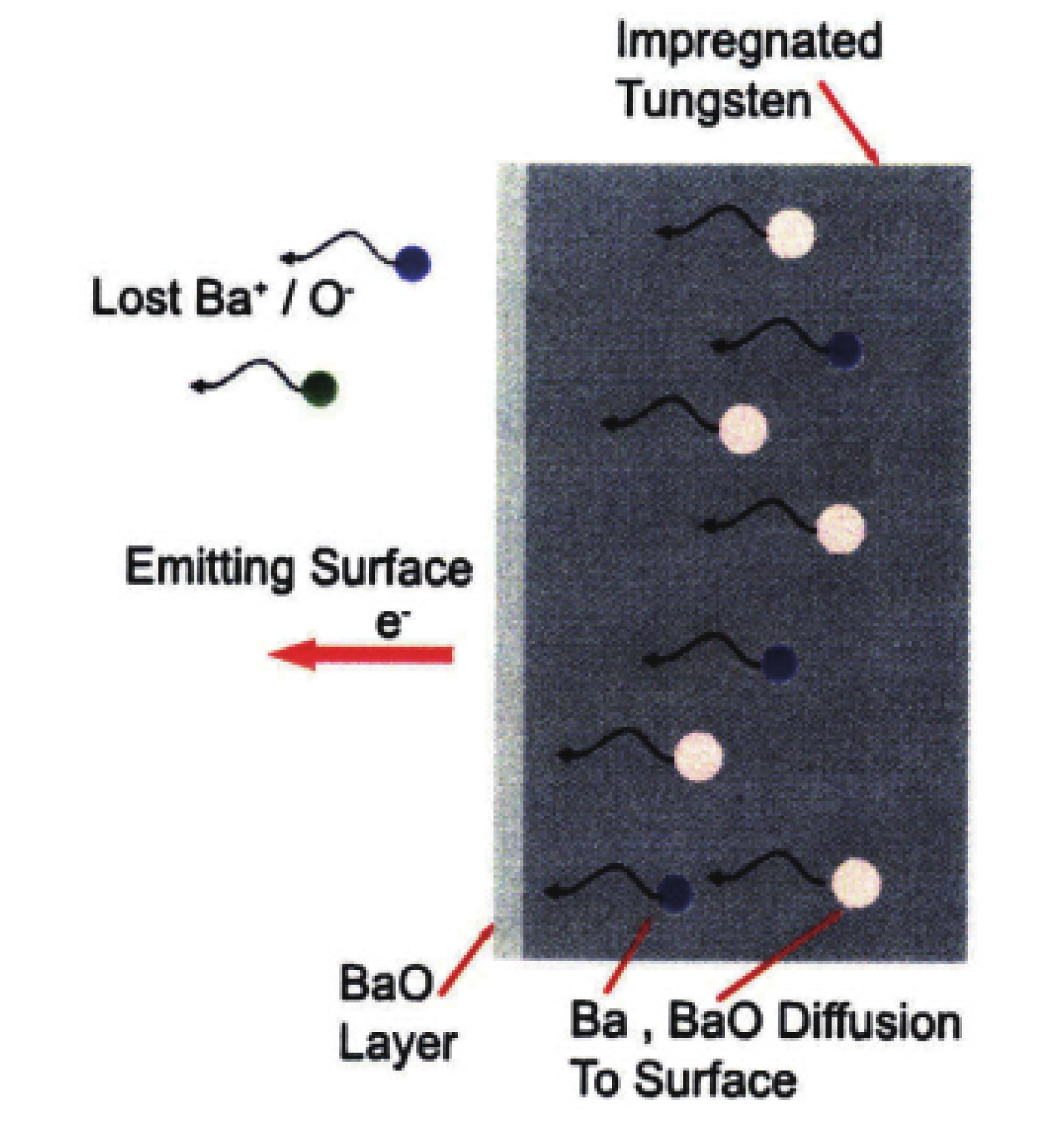
 下载:
下载:
